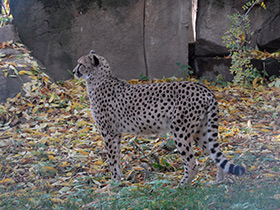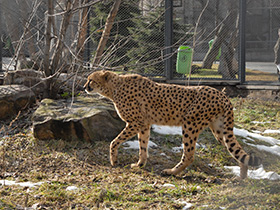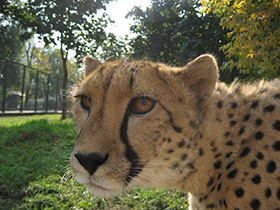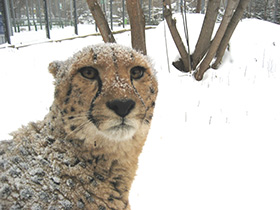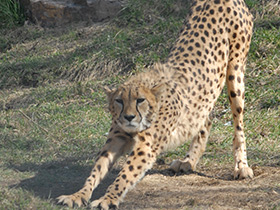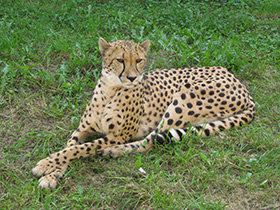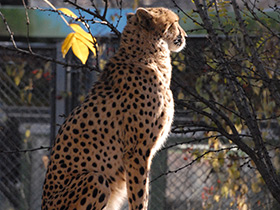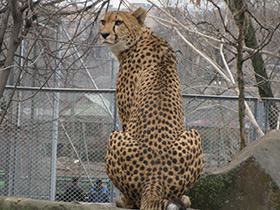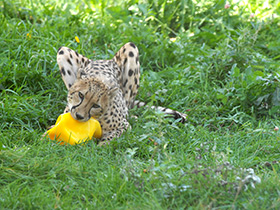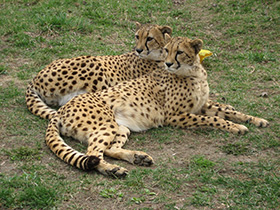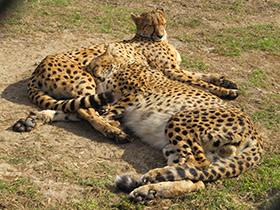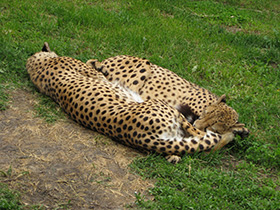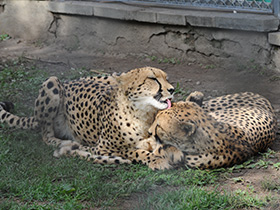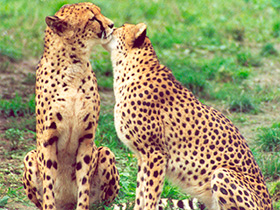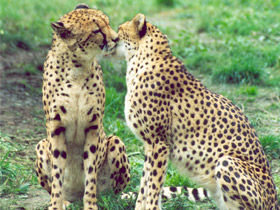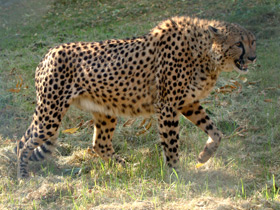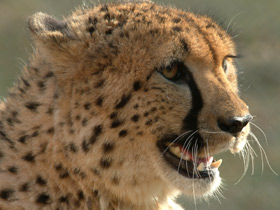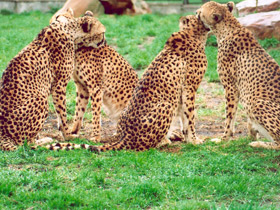The cheetah (Acinonyx jubatus)
 The cheetah (Acinonyx jubatus) is included in the Russian Red List
The cheetah (Acinonyx jubatus) is included in the Russian Red List
 The cheetah (Acinonyx jubatus) is included in the IUCN Red List as a "vulnerable species"
The cheetah (Acinonyx jubatus) is included in the IUCN Red List as a "vulnerable species"
Appearance and characteristics
The cheetah (Acinonyx jubatus) is an atypical member of the felid family. It is the only living representative of the genus Acinonyx.
Acinonyx jubatus is also a cat, but a unique cat! This animal is so peculiar that zoologists have identified it as a separate genus or even as a subfamily. The distinctive features of Acinonyx jubatus are related, first of all, to its unusual way of hunting for felines: it chases its prey.
Even from the outside, this striking predator looks more like a slender, long-legged hound than a cat (photos 1, 2, 7, 8). It has a small head, high eyes and small, rounded ears (photos 3, 4, 5), all to give its body streamlined properties. The claws of Acinonyx jubatus are not retracted like those of other felines - this helps it to have a better grip on the ground and not to lose stability during running when running at high speed (6-7 m). Its unusually flexible spine (photo 6) and long spotted tail allow Acinonyx jubatus to make sharp turns at full speed.
The main prey of this predator are small, fast-footed antelopes. During the hunt, it first sneaks up on them and then tries to catch them in a short run, during which it often runs at speeds of over 100 km/h.
Acinonyx jubatus is a natural sprinter, accelerating to 85 km/h in 3 seconds, faster than a Ferrari. But such a fast run lasts a maximum of twenty seconds over a distance of no more than 400m. If it continues, the muscles will need so much oxygen that not even the strong heart and bulky lungs of Acinonyx jubatus will be able to provide. Thus, if it fails to catch its prey within the first few hundred metres, the hunter simply has to give up the chase. Its jaws are rather weak, but the Acinonyx jubatus has a large, sharp claw on the first toe. When hunting, it uses this as its main weapon, hooking its prey by the side or hind leg and dropping it to the ground.
The cheetah was first described in the late 18th century. Four subspecies are recognised today that are native to Africa and central Iran. An African subspecies was introduced to India in 2022. It is now distributed mainly in small, fragmented populations in northwestern, eastern and southern Africa and central Iran. It lives in a variety of habitats such as savannahs in the Serengeti, arid mountain ranges in the Sahara and hilly desert terrain.
Breeding
The social life of these unique carnivores is also rather unusual: the males of a brood usually join in groups (so-called coalitions), which live and hunt together; females, as a rule, lead a solitary life. Sometimes, however, several sisters may breed together (in captivity, unrelated females also join together).
Gestation lasts between 85 and 95 days, after which two to six kittens are born. The defenceless kittens are easy prey for any predator, as Acinonyx jubatus have no den.
However, they have a thick ash "mane" (or mantle) that extends from neck to tail and, like a camouflage coat, reliably covers the young from the eyes of the enemy. Around the tenth day the cubs' eyes open and by three weeks of age they are able to follow their mother. But even mature Acinonyx jubatus cubs cannot hunt fast-footed antelope without the mother's help, and only at 18-22 months are they fully independent.
Taxonomy
In 1777, Johann Christian Daniel von Schreber described the cheetah based on a skin from the Cape of Good Hope and gave it the scientific name Felis jubatus. Joshua Brookes proposed the generic name Acinonyx in 1828. In 1917, Reginald Innes Pocock placed the cheetah in a subfamily of its own, Acinonychinae, given its striking morphological resemblance to the greyhound and significant deviation from typical felid features; the cheetah was classified in Felinae in later taxonomic revisions.
In the 19th and 20th centuries, several cheetah specimens were described; some were proposed as subspecies. An example is the South African specimen known as the "woolly cheetah", named for its notably dense fur—this was described as a new species (Felis lanea) by Philip Sclater in 1877, but the classification was mostly disputed. There has been considerable confusion in the nomenclature of cheetahs and leopards (Panthera pardus) as authors often confused the two; some considered "hunting leopards" an independent species, or equal to the leopard.
Subspecies
Five subspecies are recognised:
- Asiatic cheetah (Acinonyx jubatus venaticus);
- Transcaspian cheetah (Acinonyx jubatus raddei);
- Northwest African cheetah (Acinonyx jubatus hecki);
- Central African or Sudanese cheetah (Acinonyx jubatus soemmerringi)Acinonyx jubatus fearsoni;
- Acinonyx jubatus jubatus jubatus.
Fossil record
The oldest fossil remains of A. jubatus come from Layer I of the Olduvai Gorge, formed in the Gelasian (Lower Pleistocene), the top of which is dated to 1.8 million years ago.
Economic importance
Cheetah skin was considered a status symbol. Today, cheetahs are of increasing economic importance for ecotourism and are also found in zoos. They also attract the curiosity of photographic safaris, where sometimes up to fifteen groups of people gather. This intrusion is annoying, but provides an economic alternative to poaching or animal trafficking.
Cheetahs are much less aggressive than other big cats and can be tamed, so cubs are sometimes sold as pets.
They used to be hunted - even today - because many farmers believe they eat livestock. When the species became endangered, numerous campaigns were launched to try to educate farmers and encourage them to conserve the cheetah. Recent evidence has shown that cheetahs do not attack or eat livestock if they can avoid it, preferring their prey in the wild. However, they have no problem including farmland as part of their territory, which sometimes causes conflict.
Ancient Egyptians routinely kept them as pets and they were also trained to hunt: cheetahs are believed to have been led into hunting camps, blindfolded, hooded and held on leashes, while the dogs would flush their prey. When the prey was close enough, the cheetahs were probably released and the blindfolds removed. This tradition came to the ancient Persians and then to India.
Threats
The cheetah is threatened by several factors, like habitat loss and fragmentation of populations. Habitat loss is caused mainly by the introduction of commercial land use, such as agriculture and industry. It is further aggravated by ecological degradation, like bush encroachment, which is common in southern Africa. Moreover, the species apparently requires a sizeable area to live in as indicated by its low population densities. Shortage of prey and conflict with other species such as humans and large carnivores are other major threats. The cheetah appears to be less capable of coexisting with humans than the leopard. With 76% of its range consisting of unprotected land, the cheetah is often targeted by farmers and pastoralists who attempt to protect their livestock, especially in Namibia. Illegal wildlife trade and trafficking is another problem in some places (like Ethiopia). Some tribes, like the Maasai people in Tanzania, have been reported to use cheetah skins in ceremonies. Roadkill is another threat, especially in areas where roads have been constructed near natural habitat or protected areas. Cases of roadkill involving cheetahs have been reported from Kalmand, Touran National Park, and Bafq in Iran. The reduced genetic variability makes cheetahs more vulnerable to diseases; however, the threat posed by infectious diseases may be minor, given the low population densities and hence a reduced chance of infection.
Conservation
The cheetah has been classified as Vulnerable by the IUCN; it is listed under Appendix I of the CMS and Appendix I of CITES. The Endangered Species Act enlists the cheetah as Endangered.


















